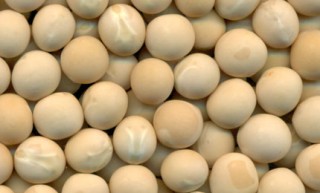Grain Legume Crops Sustainable, Nutritious

Tom Warkentin, University of Saskatchewan A new variety of pea, CDC Saffron. Peas contain micronutrients essential for good nutrition.
These items are called macronutrients, and we consume them in relatively large quantities. However, micronutrients often receive less attention. Micronutrients are chemicals, including vitamins and minerals, that our bodies require in very small quantities. Common mineral micronutrients include zinc, iron, manganese, magnesium, potassium, copper, and selenium.
A recent study published in Crop Science examined the mineral micronutrient content of crops grown in the province of Saskatchewan, Canada. The study was conducted jointly by the University of Saskatchewan and North Dakota State University. The researchers examined four types of grain legumes (pulses)—field peas, lentils, chickpeas, and common bean.
Although these legumes have up to twice the micronutrients as cereals, according to Tom Warkentin, professor of plant breeding at the University of Saskatchewan, they are not cultivated on the same scale as cereals in most countries. Therefore, grain legume crops are often overlooked as potentially valuable sources of micronutrients.
Diets that do not provide adequate amounts of micronutrients lead to a variety of diseases that affect most parts of the human body. Warkentin says, “Iron deficiency is the most common, followed by zinc, carotenoids, and folate.”
The study found that genetic characteristics (genotype) as well as environmental conditions—such as soil properties and local climate—can affect the micronutrient content of grain legumes. The researchers measured micronutrient levels by a technique known as atomic absorption spectrometry. According to Warkentin, “In the case of selenium, we found that environmental conditions are more important than genotype.”
Warkentin notes, “A 100-gram (3 ½-ounce) serving of any one of the four grain legume crops studied provided a substantial portion of the recommended daily allowance (RDA) of iron, zinc, selenium, magnesium, manganese, copper, and nickel.” The serving size was based on the dry weight of the grain legumes. He adds that lentils were the best source of iron, while chickpeas and common bean were higher in magnesium. Calcium was the only key micronutrient that these crops lacked.
Interestingly, most of the crops studied were high in selenium, with chickpeas and lentils being the best sources. Selenium is an important but often overlooked micronutrient. Selenium deficiency can lead to diseases that weaken heart muscles and cause breakdown of cartilage. It can also give rise to hypothyroidism, since selenium is a required chemical in the production of thyroid hormone.
Warkentin concludes, “Increased production and consumption of grain legume crops should be encouraged by agriculturalists and dietitians around the world.” Since grain legume crops don’t require nitrogen-based fertilizers, which are derived from fossil fuels, they are very sustainable. Warkentin also says, “Grain legume crops are highly nutritious. In addition to the micronutrients described in this research, they also contain 20-25% protein, 45-50% slowly digestible starch, soluble and insoluble fiber, and are low in fat.”
Access the full article here:
Media Contact
More Information:
http://www.sciencesocieties.orgAll latest news from the category: Health and Medicine
This subject area encompasses research and studies in the field of human medicine.
Among the wide-ranging list of topics covered here are anesthesiology, anatomy, surgery, human genetics, hygiene and environmental medicine, internal medicine, neurology, pharmacology, physiology, urology and dental medicine.
Newest articles

Silicon Carbide Innovation Alliance to drive industrial-scale semiconductor work
Known for its ability to withstand extreme environments and high voltages, silicon carbide (SiC) is a semiconducting material made up of silicon and carbon atoms arranged into crystals that is…

New SPECT/CT technique shows impressive biomarker identification
…offers increased access for prostate cancer patients. A novel SPECT/CT acquisition method can accurately detect radiopharmaceutical biodistribution in a convenient manner for prostate cancer patients, opening the door for more…

How 3D printers can give robots a soft touch
Soft skin coverings and touch sensors have emerged as a promising feature for robots that are both safer and more intuitive for human interaction, but they are expensive and difficult…





















